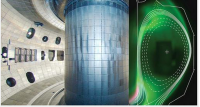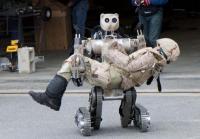-
Instant water heater offers energy, cost savings
Traditional water heaters take time to reach preferred temperatures, thus wasting water and energy. A new instant hot water solution, developed through the EU-funded RAPIDHEAT project, successfully optimized heating and control technologies to develop a lightweight low thermal mass heater that provides full temperature output within two seconds of switch-on.
-
-
An app alerts people, law enforcement about potential crime risk
You are walking home after a night out on a dark autumn evening. Suddenly, you get the feeling that someone is following you. You look over your shoulder, and see a shadow between the trees in the park. You quicken your steps. When you glance behind you again, you see the shadow disappear in between two houses. This is when you could press the “help” button on the app that you have downloaded. It sends a message to everyone in the area who also has the app, with information about your phone number and where you are. This way they are able to call you, alert emergency services, or get to your location if need be. The app has been developed by a group of student entrepreneurs.
-
-
New flame retardant is naturally derived, nontoxic
Flame retardants are added to foams found in mattresses, sofas, car upholstery, and many other consumer products. Once incorporated into foam, these chemicals can migrate out of the products over time, releasing toxic substances into the air and environment. Inspired by a naturally occurring material found in marine mussels, researchers have created a new flame retardant to replace commercial additives that are often toxic and can accumulate over time in the environment and living animals, including humans.
-
-
Recovering rare earth materials from electric and hybrid vehicle motors
China currently supplies about 97 percent of rare earth materials used in manufacturing around the world. In an effort to help develop a sustainable domestic supply of rare earth elements and lessen the U.S. dependence on China for materials that are vital to the production of electronics, wind turbines, and many other technologies, researchers have developed a method of extracting rare earths from the drive units and motors of discarded electric and hybrid cars.
-
-
Clothing that guards against chemical warfare agents
Recent reports of chemical weapons attacks in the Middle East underscore the need for new ways to guard against their toxic effects. Scientists report that a new hydrogel coating that neutralizes both mustard gas and nerve agent VX. It could someday be applied to materials such as clothing and paint.
-
-
DHS recruits Silicon Valley entrepreneurs to develop first-response technology
DHS wants better technology for first responders — police, firefighters, and EMTs — but rather than pushing for innovation from within the massive corporations that already provide technology to government agencies, the DHS has come to Silicon Valley to tap the entrepreneurial ecosystem of northern California. Giant technology firms have resources of large scale manufacturing and distribution, but there is one crucial difference. Technology startups are much more nimble, and can shift their development much faster than the huge corporations can.
-
-
Small-scale nuclear fusion may be a new energy source

Nuclear fusion is a process whereby atomic nuclei melt together and release energy. Because of the low binding energy of the tiny atomic nuclei, energy can be released by combining two small nuclei with a heavier one. Fusion energy may soon be used in small-scale power stations. This means producing environmentally friendly heating and electricity at a low cost from fuel found in water. Both heating generators and generators for electricity could be developed within a few years, according to researchers.
-
-
Robots to pull wounded soldiers off battlefield

Most Americans have seen at least one war movie, where at some point a fresh-faced young private is hit with some shrapnel. From the ground, he calls out for the unit medic — another young guy, from another small town, whose quick reaction and skill just may save his life. In the near future, however, it may no longer be another soldier, who comes running to his side. Instead, it might be an Army-operated unmanned aerial or ground vehicle.
-
-
Testing radiation detection systems in harsh conditions
Researchers from five laboratories and a private company recently spent two days in blistering 100 degree heat testing radiation detection technologies amidst cargo containers. The fifteen researchers demonstrated the feasibility of using gamma-ray and neutron imaging detectors to identify radioactive materials using the Lawrence Livermore National Laboratory’s (LLNL) cargo container stack testbed.
-
-
Seeing through the dark clearly

A new device, dubbed Thermal on Demand (TOD), allows firefighters to see everything in a heavily smoke-filled room, where the unassisted eye sees nothing but a pitch-black environment. TOD allows responders to see doors, furniture, light switches, debris on the floor, and victims lying on the floor. Looking through a periscopic lens, in front of a thermal camera, the wearer sees a detailed image of everything in the immediate vicinity.
-
-
Engineers design invisibility cloak for military drones
Inspired by the well-known Invisibility Cloak from Harry Potter, electrical engineers have created a new design for their cloaking device, using a Teflon substrate, studded with cylinders of ceramic, which is thinner than any prior development and does not alter the brightness of light around concealed objects. The Teflon has a low refractive index, while the ceramic’s refractive index is higher, which allows light to be dispersed through the sheet without any absorption. Compared to an invisibility cloak, this technology has not only the ability to conceal, but the ability to increase optical communication signal speed and to collect solar energy.
-
-
How Western Europe came to dominate the globe

Although Europe represents only about 8 percent of the planet’s landmass, from 1492 to 1914, Europeans conquered or colonized more than 80 percent of the entire world. There are many possible explanations for why history played out this way, but few can explain why the West was so powerful for so long. Caltech’s Philip Hoffman, a professor of business economics and history, has a new explanation: the advancement of gunpowder technology. The Chinese invented gunpowder, but Hoffman argues that certain political and economic circumstances allowed the Europeans to advance gunpowder technology at an unprecedented rate — allowing a relatively small number of people quickly to take over much of the rest of the globe. What lessons does his explanation of the West’s rise to dominance offer for today’s policy makers? “In a world where there are hostile powers, we really don’t want to get rid of spending on improving military technology,” Hoffman says. “I would much rather see expenditures devoted to infrastructure, or scientific research, or free preschool for everybody – things that would carry big economic benefits,” and “I wish we did live in that world, but unfortunately it’s not realistic.”
-
-
Prepaid card reader helps law enforcement in seizing fraudulent cards
During arrests of criminal couriers, law enforcement officers rarely find bundles of cash wrapped in rubber bands anymore. Instead, they find stacks of plastic cards — bank credit and debit cards, retail gift cards, library cards, hotel card keys, even magnetic-striped Metrorail cards — which have been turned into prepaid cards. DHS S&T’s Electronic Recovery and Access to Data (ERAD) Prepaid Card Reader is a small, handheld device which uses wireless connectivity to allow law enforcement officers in the field to check the balance of cards. This allows for identification of suspicious prepaid cards and the ability to put a temporary hold on the linked funds until a full investigation can be completed.
-
-
Wearable device helps medics save lives in disasters, on the battlefield
The First Response Monitor is a wearable device designed to measure and monitor the vital signs of multiple trauma patients for emergency response in disasters and battlefield situations. The device has been primarily designed with first response medics in mass casualty incidents in mind, but it has applications in many other fields — such as civilian medicine where additional monitoring of conditions has benefit in patient outcomes, wellness monitoring, and within sports for training and performance monitoring.
-
-
New technology solves city pipelines leakage problem without excavation

In Mexico City there are twenty-six thousand kilometers of water pipes and drainage, of which about 8,000 are useless, with risk of collapse and resulting cuts in service. The water pipes infrastructure of many other cities is not much better. A Mexican start-up has created a technology to renew piping without the need for excavation, ensuring it lasts fifty years, twice as long as traditional piping.
-
More headlines
The long view
Autonomous Vehicle Technology Vulnerable to Road Object Spoofing and Vanishing Attacks
Researchers have demonstrated the potentially hazardous vulnerabilities associated with the technology called LiDAR, or Light Detection and Ranging, many autonomous vehicles use to navigate streets, roads and highways. The researchers have shown how to use lasers to fool LiDAR into “seeing” objects that are not present and missing those that are – deficiencies that can cause unwarranted and unsafe braking or collisions.
Tantalizing Method to Study Cyberdeterrence
Tantalus is unlike most war games because it is experimental instead of experiential — the immersive game differs by overlapping scientific rigor and quantitative assessment methods with the experimental sciences, and experimental war gaming provides insightful data for real-world cyberattacks.
Prototype Self-Service Screening System Unveiled
TSA and DHS S&T unveiled a prototype checkpoint technology, the self-service screening system, at Harry Reid International Airport (LAS) in Las Vegas, NV. The aim is to provide a near self-sufficient passenger screening process while enabling passengers to directly receive on-person alarm information and allow for the passenger self-resolution of those alarms.
Falling Space Debris: How High Is the Risk I'll Get Hit?
An International Space Station battery fell back to Earth and, luckily, splashed down harmlessly in the Atlantic. Should we have worried? Space debris reenters our atmosphere every week.
Testing Cutting-Edge Counter-Drone Technology
Drones have many positive applications, bad actors can use them for nefarious purposes. Two recent field demonstrations brought government, academia, and industry together to evaluate innovative counter-unmanned aircraft systems.
Strengthening the Grid’s ‘Backbone’ with Hydropower
Argonne-led studies investigate how hydropower could help add more clean energy to the grid, how it generates value as grids add more renewable energy, and how liner technology can improve hydropower efficiency.
The Tech Apocalypse Panic is Driven by AI Boosters, Military Tacticians, and Movies
From popular films like a War Games or The Terminator to a U.S. State Department-commissioned report on the security risk of weaponized AI, there has been a tremendous amount of hand wringing and nervousness about how so-called artificial intelligence might end up destroying the world. There is one easy way to avoid a lot of this and prevent a self-inflicted doomsday: don’t give computers the capability to launch devastating weapons.
The Tech Apocalypse Panic is Driven by AI Boosters, Military Tacticians, and Movies
From popular films like a War Games or The Terminator to a U.S. State Department-commissioned report on the security risk of weaponized AI, there has been a tremendous amount of hand wringing and nervousness about how so-called artificial intelligence might end up destroying the world. There is one easy way to avoid a lot of this and prevent a self-inflicted doomsday: don’t give computers the capability to launch devastating weapons.
